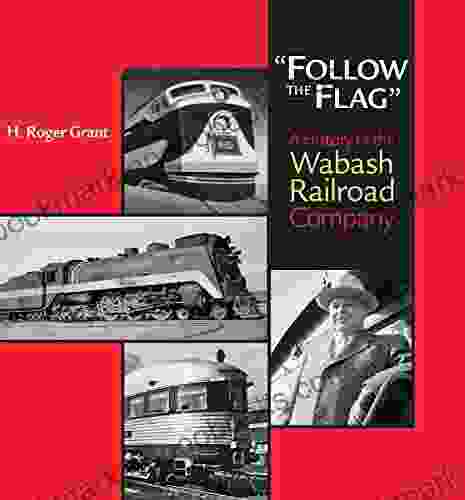History of the Wabash Railroad Company: A Testament to the Iron Arteries of America

: The Forging of a Transportation Empire

4.9 out of 5
| Language | : | English |
| File size | : | 12318 KB |
| Text-to-Speech | : | Enabled |
| Screen Reader | : | Supported |
| Enhanced typesetting | : | Enabled |
| Word Wise | : | Enabled |
| Print length | : | 299 pages |
In the tapestry of American history, the Wabash Railroad Company stands as a testament to the transformative power of transportation. Its humble beginnings can be traced back to the bustling hub of Toledo, Ohio, where a group of enterprising businessmen recognized the need for a vital rail link between the Midwest and the East Coast. With unwavering determination, they embarked on a journey that would forever alter the course of America's economic and social fabric.
Chapter 1: The Golden Age of Railroading
The mid-19th century marked the golden age of railroad expansion in America. As the nation pushed westward, railroads became the arteries that carried settlers, goods, and ideas to the frontiers. The Wabash Railroad emerged as a major player in this transformative era, playing a pivotal role in unlocking the economic potential of the Midwest.
Section 1: Building the Infrastructure of Progress
Driven by the insatiable demand for transportation, the Wabash Railroad embarked on an ambitious expansion plan. With meticulous precision, its engineers surveyed vast territories, laying tracks that connected sprawling cities and opened up rural areas for development. The iconic Wabash bridges, marvels of engineering, spanned mighty rivers and treacherous ravines, ensuring the seamless flow of commerce and communication.
Section 2: The Economic Engine of the Midwest
The arrival of the Wabash Railroad in towns and cities across the Midwest acted as a catalyst for economic growth. Farmers gained access to new markets, allowing them to expand their operations and increase their profits. Industries flourished, attracted by the efficient transportation network that the railroad provided. The Wabash Railroad became the lifeline of the region, fueling prosperity and transforming the economic landscape.
Chapter 2: The Challenges and Triumphs of the 20th Century
As the 20th century dawned, the Wabash Railroad faced new challenges and opportunities. Advances in technology demanded adaptation, and the company invested heavily in modern locomotives and railcars. At the same time, competition from other railroads and emerging modes of transportation intensified.
Section 1: Navigating the Industrial Revolution
The rise of the automobile and the advent of trucking threatened the dominance of railroads. To remain competitive, the Wabash Railroad embraced innovation, streamlining its operations and introducing new services. It invested in intermodal transportation, combining rail and truck networks to provide efficient and cost-effective shipping solutions.
Section 2: A Legacy of Innovation and Customer Service
Throughout the 20th century, the Wabash Railroad maintained its reputation for excellence in customer service. Its signature "Blue Bird" passenger trains became renowned for their comfort, speed, and reliability. The company's commitment to meeting the needs of its patrons ensured its continued success in an increasingly competitive market.
Chapter 3: The Modern Era: Consolidation and Preservation
The latter half of the 20th century witnessed a wave of consolidation in the railroad industry. The Wabash Railroad, once an independent giant, became part of the Norfolk and Western Railway. Despite this transition, the company's legacy lived on, preserved in museums and historical societies.
Section 1: Preserving a Transportation Icon
Recognizing the immense historical significance of the Wabash Railroad, efforts were made to preserve its legacy. Historic locomotives, passenger cars, and depots were meticulously restored, offering a glimpse into the golden age of railroading. Museums and tourism boards celebrated the company's contributions, ensuring that its story would continue to be told.
Section 2: The Wabash Trail: A Legacy for Outdoor Enthusiasts
In a unique tribute to the Wabash Railroad, a scenic hiking and biking trail was established along the former rail corridor. Stretching for hundreds of miles, the Wabash Trail provides outdoor enthusiasts with an opportunity to explore the natural beauty of the region while honoring the legacy of the railroad that once shaped its destiny.
: The Enduring Impact of the Wabash Railroad
The history of the Wabash Railroad Company is a captivating narrative of innovation, perseverance, and economic transformation. Its early pioneers played a pivotal role in shaping the transportation landscape of America, connecting communities, and fueling economic growth. Through its challenges and triumphs, the Wabash Railroad emerged as a symbol of American ingenuity and resilience.
Today, the legacy of the Wabash Railroad lives on, preserved in museums and historical sites. The Wabash Trail invites visitors to explore the company's rich past while enjoying the beauty of the countryside. And as the transportation industry continues to evolve, the spirit of the Wabash Railroad serves as a reminder of the enduring power of transportation to connect and empower nations.
4.9 out of 5
| Language | : | English |
| File size | : | 12318 KB |
| Text-to-Speech | : | Enabled |
| Screen Reader | : | Supported |
| Enhanced typesetting | : | Enabled |
| Word Wise | : | Enabled |
| Print length | : | 299 pages |
Do you want to contribute by writing guest posts on this blog?
Please contact us and send us a resume of previous articles that you have written.
 Book
Book Novel
Novel Page
Page Chapter
Chapter Text
Text Story
Story Genre
Genre Reader
Reader Library
Library Paperback
Paperback E-book
E-book Magazine
Magazine Newspaper
Newspaper Paragraph
Paragraph Sentence
Sentence Bookmark
Bookmark Shelf
Shelf Glossary
Glossary Bibliography
Bibliography Foreword
Foreword Preface
Preface Synopsis
Synopsis Annotation
Annotation Footnote
Footnote Manuscript
Manuscript Scroll
Scroll Codex
Codex Tome
Tome Bestseller
Bestseller Classics
Classics Library card
Library card Narrative
Narrative Biography
Biography Autobiography
Autobiography Memoir
Memoir Reference
Reference Encyclopedia
Encyclopedia Dylan Thomas
Dylan Thomas Kathryn Adams
Kathryn Adams Dylan Cramer
Dylan Cramer Sara Mills
Sara Mills Edie Baylis
Edie Baylis Sam Sax
Sam Sax Maxim Ross
Maxim Ross Ronald A Rufo
Ronald A Rufo Elizabeth Heiter
Elizabeth Heiter Kaye Draper
Kaye Draper Ednah Walters
Ednah Walters Eduard Fischer
Eduard Fischer Mandy Magro
Mandy Magro Sonali Dev
Sonali Dev Zoe Hampton
Zoe Hampton Fernanda Young
Fernanda Young Edwin Crane
Edwin Crane Rebecca Peabody
Rebecca Peabody Tanja Stern
Tanja Stern Mica Pollock
Mica Pollock
Light bulbAdvertise smarter! Our strategic ad space ensures maximum exposure. Reserve your spot today!

 Rick NelsonMitochondrial Night: A Novel of Tragedy, Triumph, and the Power of the Human...
Rick NelsonMitochondrial Night: A Novel of Tragedy, Triumph, and the Power of the Human...
 Aubrey BlairHood Love and Loyalty: A Gripping Tale of Love, Loyalty, and Betrayal in the...
Aubrey BlairHood Love and Loyalty: A Gripping Tale of Love, Loyalty, and Betrayal in the... William GoldingFollow ·12.3k
William GoldingFollow ·12.3k T.S. EliotFollow ·18.1k
T.S. EliotFollow ·18.1k Kirk HayesFollow ·3.1k
Kirk HayesFollow ·3.1k Justin BellFollow ·15.1k
Justin BellFollow ·15.1k Forrest BlairFollow ·10.1k
Forrest BlairFollow ·10.1k Jeremy CookFollow ·14.8k
Jeremy CookFollow ·14.8k Stuart BlairFollow ·7.1k
Stuart BlairFollow ·7.1k Gilbert CoxFollow ·18.4k
Gilbert CoxFollow ·18.4k

 Eugene Powell
Eugene PowellFat Cat Stories: Level At Word Family - A Purrfect Start...
Introducing the 'At'...

 William Powell
William PowellUnveiling the Treasures of Russian Poetry: The Cambridge...
Immerse yourself in the...

 Roberto Bolaño
Roberto BolañoUnveiling the Treasures of Beowulf: A Guided Tour with...
: Delving into the...

 Foster Hayes
Foster HayesTransport, Climate Change and the City: Tackling Urban...
Transport is a major...

 Calvin Fisher
Calvin FisherHow To Make It In The Music Industry: The Ultimate Guide...
Are you an aspiring musician with...

 Rick Nelson
Rick NelsonUnveiling the Enigmatic World of Gary Chester's "The New...
Step into a World...
4.9 out of 5
| Language | : | English |
| File size | : | 12318 KB |
| Text-to-Speech | : | Enabled |
| Screen Reader | : | Supported |
| Enhanced typesetting | : | Enabled |
| Word Wise | : | Enabled |
| Print length | : | 299 pages |








